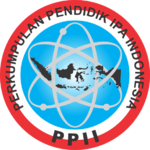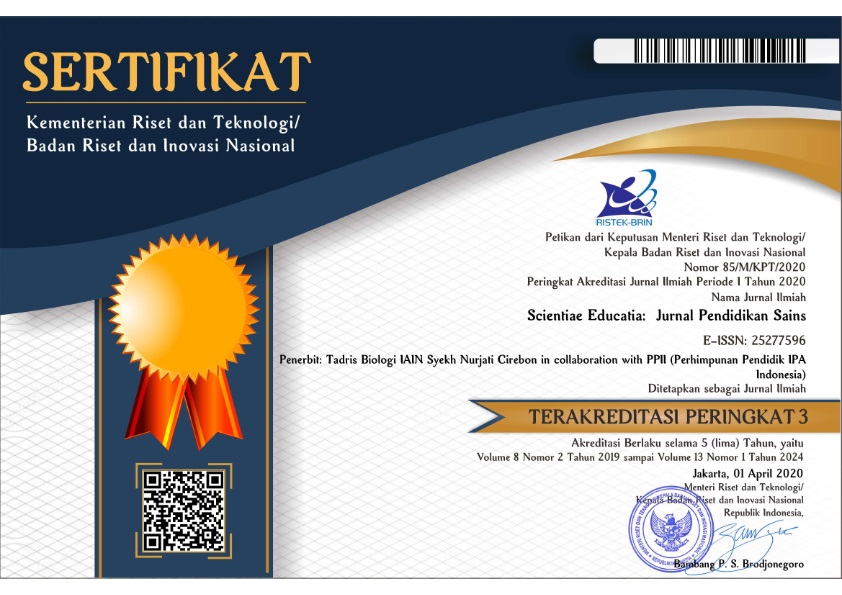Profile of Creative Thinking Skills on Junior High School Students in Science Learning by Gender
(1) Master of Education in Science Programme, Universitas Sebelas Maret
(2) Master of Education in Chemistry Programme, Universitas Sebelas Maret
(3) Master of Education in Chemistry Programme, Universitas Sebelas Maret
(*) Corresponding Author
Abstract
Creative thinking is one of the essential skills in science learning. Creative thinking skills become a source of strength in the development, invention, and investigation to face the obstacles in the 21st century. This study aimed to determine the creative thinking skills of junior high school students in science learning by gender. This study used descriptive analysis with quantitative data. Data collection by tests, interviews, and observation sheets. The participants of this study were 94 students from three different schools consisting of 35 male and 59 female students. The sampling technique uses purposive sampling. Indicators of critical thinking are fluency, flexibility, originality, and elaboration. Creative thinking skills in this study divided into three categories: high, medium, and low. The result of this study showed that the male students have a high percentage of flexibility, the average percentage in both originality and fluency, and a low percentage in elaboration. Female students have a high percentage in fluency, the medium percentage in elaboration, and a low percentage in both originality and flexibility.
Keywords
Full Text:
PDFReferences
Abraham, A. (2016). Gender and creativity: An overview of psychological and neuroscientific literature. Brain Imaging and Behavior, 10(2), 609–618.
Afidah, I. N. (2012). Pengaruh penerapan metode Socratic Circles disertai media gambar terhadap kemampuan berfikir kreatif siswa. Jurnal Pendidikan Biologi, 4(3), 1–15.
Ali, M., & Asrori, M. (2011). Psikologi Remaja Perkembangan Peserta Didik. Jakarta: PT Bumi Aksara.
Arikunto, S. (2010). Prosedur Penelitian Suatu Pendekatan dan Praktik. Jakarta: PT Rineka Cipta.
Azhari, A., & Somakim, S. (2014). Peningkatan Kemampuan Berpikir Kreatif Matematik Siswa Melalui Pendekatan Konstruktivisme Di Kelas VII Sekolah Menengah Pertama (SMP) Negeri 2 Banyuasin III. Jurnal Pendidikan Matematika, 8(1), 1-12.
Bahriah, E. S. (2012). Pengembangan multimedia interaktif kesetimbangan kimia untuk meningkatkan literasi sains siswa (Doctoral dissertation, Universitas Pendidikan Indonesia). Retrieved from http://repository.upi.edu/9901/
Bart, W. M., Hokanson, B., Sahin, I., & Abdelsamea, M. A. (2015). An investigation of the gender differences in creative thinking abilities among 8th and 11th grade students. Thinking Skills and Creativity, 17, 17-24.
Carin, A. A., & Sund, R. B. (2017). Model Silabus Mata Pelajaran SMP/ MTs. Columbus: Merrill Publishing Company.
Cujbă, T. O. (2010). Considerations on Creativity Motivation. Buletinul Universitanii Petrol – Gaze Din Ploiesti. Ştiinele Educanie, LXII(2), 154–159.
Ekawati, A., & Wulandari, S. (2011). Perbedaan jenis kelamin terhadap kemampuan siswa dalam mata pelajaran matematika (studi kasus sekolah dasar). Jurnal Socioscienta, 3(1), 19-24.
Fauzi, A. & Sa’diyah, W. (2019). Students’ metacognitive skills from the viewpoint of answering biological questions: Is it already good? Jurnal Pendidikan IPA Indonesia, 8(3), 317–327.
Ghufron, M. N., & Risnawati, S. R. (2014). Teori-teori Psikologi. Yogyakarta: Ar-Ruzz media.
Gie, T. (2003). Teknik-teknik Berpikir Kreatif. Yogyakarta: Multi Pressindo.
Handayani, T., & Sugiarti. (2002). Konsep dan Teknik Penelitian Gender. Malang: Universitas Muhamadiyah Malang Press.
He, W. J., & Wong, W. C. (2011). Gender differences in creative thinking revisited: Findings from analysis of variability. Personality and Individual Differences, 51(7), 807-811.
Irvani, F. A., Suharto, S., & Kurniati, D. (2016). Profil berpikir kreatif siswa laki-laki dan perempuan kelas VIII SMP Nuris Jember dalam menyelesaikan soal cerita pokok bahasan segiempat. Kadikma, 7(1), 105-113.
Ismaimuza, D. (2013). Kemampuan berpikir kritis dan kreatif matematis siswa SMP melalui pembelajaran berbasis masalah dengan strategi konflik kognitif. Sains Humanika, 63(2), 33-37.
Krisnawati. (2012). Kreativitas siswa dalam memecahkan masalah matematika divergen berdasarkan kemampuan matematika siswa. MATHEdunesa, 1(1), 1-8.
Krutetzky. (1976). The Schoolchildren Teaching and Education Psychology.
Kurnia, F., & Fathurohman, A. (2014). Analisis bahan ajar fisika SMA kelas XI di Kecamatan Indralaya Utara berdasarkan kategori literasi sains. Jurnal Inovasi dan Pembelajaran Fisika, 1(1), 43-47.
Lin, W. L., Hsu, K. Y., Chen, H. C., & Wang, J. W. (2012). The relations of gender and personality traits on different creativities: A dual-process theory account. Psychology of Aesthetics, Creativity, and the Arts, 6(2), 112-123.
Mahmudi, A. (2009). Mengembangkan kemampuan berpikir kreatif siswa melalui pembelajaran topik pecahan. In Seminar Nasional Aljabar, Pengajaran, dan Terapannya. Yogyakarta (Vol. 31).
Matud, M. P., RodrÃguez, C., & Grande, J. (2007). Gender differences in creative thinking. Personality and individual differences, 43(5), 1137-1147. doi: 10.1016/j.paid.2007.03.006
Munandar, U. (2009). Mengembangkan bakat dan kreativitas anak sekolah. Penuntun bagi guru dan Orang Tua. Jakarta: Grasindo.
Nafi’an, M. (2011). Kemampuan Siswa Dalam Menyelesaikan Soal Cerita ditinjau dari Gender Sekolah Dasar. Matematika Dan Pendidikan Karakter Dalam Pembelajaran. Yogyakarta: UNY.
Nurmitasari. (2016). Pembelajaran team assissted individualization pada lingkaran ditinjau dari jenis kelamin dan kemampuan awal. Journal Eksponen STKIP Muhammadiyah Kotabumi, 6(2), 67–77.
Nurmitasari, N., & Astuti, R. (2017). Tingkat berpikir kreatif siswa MTs. pada bangun datar ditinjau dari jenis kelamin. Jurnal e-DuMath, 3(2), 118-128.
Palennari, M., Taiyeb, M., & Saenab, S. (2018). Profile of students’ metacognitive skill based on their learning style. In Journal of Physics: Conference Serie, 1028.
Piaw, C. Y. (2013). Effects of gender and thinking style on students’ creative thinking ability. Procedia-Social and Behavioral Sciencer, 116(2014), 5135–5139.
Prayekti. (2006). Penerapan Pendekatan sains teknologi masyarakat pada pembelajaran IPA di SD. Jurdik & Hum, 9, 1-7.
Proudfoot, D., Kay, A. C., & Koval, C. Z. (2015). A gender bias in the attribution of creativity: Archival and experimental evidence for the perceived association between masculinity and creative thinking. Psychological Science, 26(11), 1751-1761.
Rahmawati, S. Y. D., Ashadi, & Susilowati, E. (2018, September). Student’s profile about critical thinking ability on hydrocarbon compounds concept. In AIP Conference Proceedings (Vol. 2014, No. 1, p. 020047). AIP Publishing.
Rashid, T., & Asghar, H. M. (2016). Technology use, self-directed learning, student engagement and academic performance: Examining the interrelations. Computers in Human Behavior, 63, 604-612.
Reuter, M., Panksepp, J., Schnabel, N., Kellerhoff, N., Kempel, P., & Hennig, J. (2005). Personality and biological markers of creativity. European Journal of Personality: Published for the European Association of Personality Psychology, 19(2), 83-95.
Santrock, J. (2014). Psikologi Pendidikan Edisi 5 Jilid 1. Jakarta: Salemba Humanika.
Shubina, I. (2017). Creativity in psychotherapy: the possibilities of its utilization. The European Proceeding of Social & Behavioural Sciences, 22, 99-111.
Shubina, I., & Kulakli, A. (2019). Critical Thinking, Creativity and Gender Differences for Knowledge Generation in Education. Literacy Information and Computer Education Journal (LICEJ), 10(1), 3086–3093.
Silver, E. A. (1997). Fostering creativity through instruction rich in mathematical problem solving and problem posing. Zdm, 29(3), 75-80.
Singh, S. K. (2014). Creative thinking among school students: comparisons across achievement category, gender, and residential background. Resesarch Journal of Social Science & Management, 4(1), 62–67.
Stoltzfus, G., Nibbelink, B. L., Vredenburg, D., & Hyrum, E. (2011). Gender, gender role, and creativity. Social Behavior and Personality: an International Journal, 39(3), 425-432.
Subarinah, S. (2013, November). Profil berpikir kreatif siswa dalam memecahkan masalah tipe investigasi matematik ditinjau dari perbedaan gender. In Seminar Nasional Matematika dan Pendidikan Matematika, 541-548. Yogyakarta, Universitas Negeri Yogyakarta.
Syarifah, H., Indriwati, S. E., & Corebima, A. D. (2016). Pengaruh Strategi Pembelajaran Reading Questioning and Answering (RQA) dipadu Think Pair Share (TPS) terhadap keterampilan metakognitif siswa laki-lai dna siswa perempuan SMAN di Kota Malang. Jurnal pendidikan;Teori, Penelitian, dan Pengembangan, 1(5), 801–805.
Torrance, E. P. (1965). Scientific views of creativity and factors affecting its growth. Creativity and Learning, 94(3), 663–681.
Ulfa, A., Ruzyati, M., Pujiastuti, P., San, S. M., & Prayitno, B. A. (2018). Profil kemampuan berpikir kreatif siswa laki-laki dan perempuan di sebuah SMA Negeri Surakarta. In Proceeding Biology Education Conference: Biology, Science, Enviromental, and Learning (Vol. 15, No. 1, pp. 532-540).
DOI: 10.24235/sc.educatia.v8i2.5315
Article Metrics
Abstract view : 192 timesPDF - 98 times
Refbacks
- There are currently no refbacks.
Scientiae Educatia: Jurnal Pendidikan Sains indexed by:

This work is licensed under a Creative Commons Attribution 4.0 International License.



1.png)












